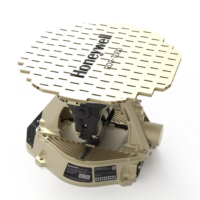Airborne radar is a vital technology for combat aircraft. It provides a means of detecting, tracking and engaging targets in the air and on the surface. Fighter aircraft radars have increased in sophistication since they first deployed on military aircraft during the Second World War.
Combat Aircraft Radar
The end of the Second World War and ensuing Cold War greatly quickened the pace of tactical aircraft radar development. The advent of high-speed jet aircraft and missiles placed a premium on fighters detecting and engaging hostile aircraft as quickly as possible. This could see engagements being performed at noticeably long ranges surpassing the abilities of human eyesight. Strike platforms like bombers and ground attack aircraft received increasingly accurate air-to-surface radars. These depicted individual targets like armored vehicles and warships in sharp detail greatly improving accuracy.
During and since the Second World War all combat aircraft radars were variations of a common design. Airborne radar signals would be transmitted and received by an antenna mounted in the nose of the aircraft. Early military aircraft radar designs used fixed antennas akin to television aerials fastened to the nose of the aircraft. Bomber radars were mounted in large radomes on an aircraft’s ventral fuselage.
Design sophistication improved in the years following the war. These antennas were replaced with dish-shaped antennas mounted inside an aircraft’s nose. These could be physically moved to point in a specific direction. For example, they could be pointed above, in front or to the side of the nose to detect and track airborne targets. They could also be pointed towards the surface to detect and track targets there. Importantly, radars are connected to air-to-air or air-to-surface missiles via radio. This lets updates on the target’s position detected by the radar to be sent to the missiles as they head to their targets.
AESA Radars
The 1990s saw a major leap forward in the design of tactical airborne radars with the adoption of Active Electronically Scanned Array (AESA) radar technology. AESA radars can move the direction of their beams without having to physically move the position of the antenna. This accelerates the speed with which a radar can detect and track a target. AESA radars also produce multitudes of individual radar beams. This means several beams can detect and track airborne targets, while others detect and track surface targets. Thus, the radar can perform several tasks simultaneously easing pilot workload.
Airborne Radar Antennas
The future may see the adoption of radar antennas positioned on military aircraft wings and fuselages rather than just in the nose. Such radars will be able to detect and track targets which a nose-mounted radar could simply not see. This is because radars can usually only detect and track targets in their line of sight. These multi-antenna radars will increase the quantity of air and surface targets a combat airborne radar can detect and track. Designs like these will help improve the aircraft’s combat performance while enhancing its protection.
Aerial Radar Background
The world’s first fighter aircraft radar was the Airborne Interception Mark Four (AI Mk.IV) which entered service en masse onboard the Royal Air Force (RAF) Bristol Beaufighter from early 1941. The acceleration of scientific innovation saw combat airborne radars adopted by several belligerents as the Second World War unfolded. For example, the Luftwaffe (German Air Force) deployed the FuG-202 Lichtenstein-B/C radar from 1942. Radar was essential to help fighters detect and intercept targets at night and in bad weather.
Likewise, bombers began to use airborne radar to determine their targets. The RAF’s Bomber Command used its H2S Mk.I/II radar from 1943 across its bomber fleet. H2S provided a reasonably clear radar picture of a city or town below the aircraft. This helped crews recognise their targets. A version known as ASV Mk.III was developed for RAF coastal command aircraft which detected semi-submerged or surfaced submarines.
















